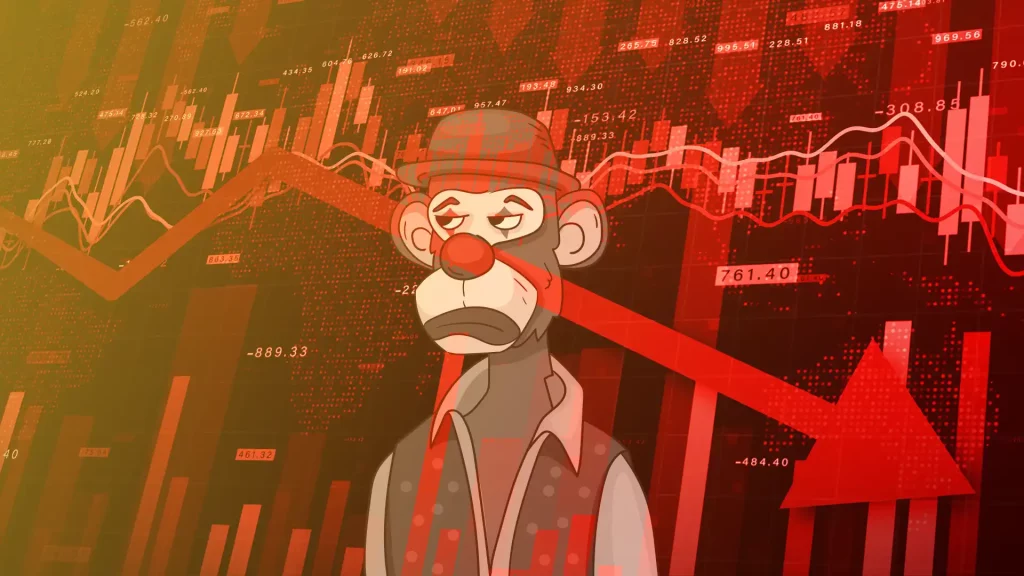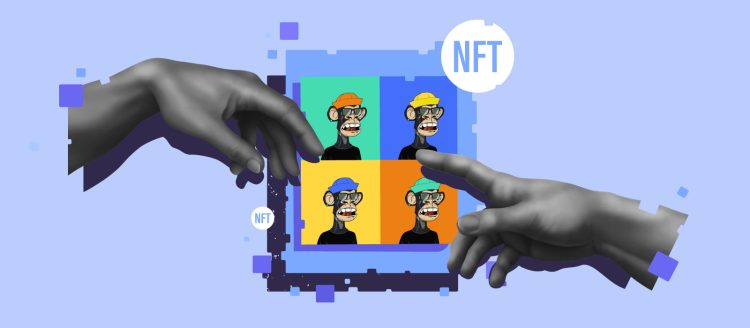Non-fungible tokens (NFTs) have garnered widespread attention in recent years, transforming from a niche digital phenomenon to a global trend. From high-profile art sales to in-game assets and real estate tokens, NFTs have raised a crucial question: Is the NFT market a passing bubble or a revolutionary force shaping the future of industries such as art, gaming, and asset management?
NFTs, by definition, are unique digital assets backed by blockchain technology, which proves their ownership and authenticity. Unlike cryptocurrencies such as Bitcoin or Ethereum, which are fungible (interchangeable), NFTs are unique and can represent everything from artwork to virtual items in games and even physical assets like real estate or luxury goods.
Despite their rapid rise, there are concerns about NFT market volatility, speculation-driven bubbles, and long-term sustainability. This article seeks to explore the real value that NFTs bring to sectors such as art, gaming, and asset management, examining whether their current popularity is just a passing phase or a legitimate transformation of traditional industries.
Understanding the NFT Phenomenon
To evaluate the value and future of NFTs, it’s essential to understand what they represent and how they function.
1. What Are NFTs?
An NFT is a digital asset representing ownership or proof of authenticity of a unique item using blockchain technology. NFTs leverage the blockchain’s ability to store immutable records, making it impossible to alter or duplicate these assets. This makes NFTs particularly useful for verifying ownership of rare or one-of-a-kind items in the digital and physical worlds.
Unlike cryptocurrencies (e.g., Bitcoin or Ethereum), NFTs cannot be exchanged on a one-to-one basis. Each NFT has its own distinct value, based on factors like rarity, demand, and cultural significance.
- Example: A digital artwork sold as an NFT is unique and cannot be replicated, even though the image itself might be easily downloadable.
- Blockchain Platform: Most NFTs are built on the Ethereum blockchain, though other platforms like Solana, Tezos, and Polygon have gained popularity due to lower transaction fees and faster processing times.
2. The Boom and Bust of the NFT Market
The NFT market saw an explosive surge in 2021, with the sale of high-profile NFTs such as Beeple’s digital artwork, which sold for a record $69 million at Christie’s auction. In a relatively short span, NFTs appeared to revolutionize various sectors, from art to gaming to fashion. However, like many speculative markets, the rapid rise also attracted concerns about overinflated valuations and the sustainability of the market.
In 2022, the NFT market witnessed significant corrections, with the price of some NFTs plummeting as speculative buying slowed down. However, the potential for NFTs to add real value in industries beyond speculation remains.
NFTs in Art: Democratizing the Creative Industry
One of the most well-known applications of NFTs is in the art world. NFT art has allowed digital artists to monetize their work in ways that were previously impossible.
1. Ownership and Provenance
NFTs provide a way to prove ownership of digital artwork, an issue that was historically problematic due to the ease of replicating digital content. For artists, NFTs are a game-changer, offering the ability to sell digital art with built-in authentication and royalties.
- Provenance: Blockchain allows every transaction and ownership transfer to be recorded, giving buyers confidence in the authenticity and origin of the art.
- Royalties: Many NFT platforms allow creators to set up smart contracts that ensure they receive a percentage of any subsequent sales of their artwork, making it possible for artists to continue earning revenue as their work changes hands in the secondary market.
2. Accessibility and Global Reach
NFTs have democratized access to the art market, traditionally dominated by galleries, museums, and auction houses. With platforms like OpenSea, Rarible, and SuperRare, artists can directly connect with global buyers without needing intermediaries. This opens up new opportunities for emerging artists and non-traditional creators who may not have access to established art institutions.
3. The Risks: Overvaluation and Speculation
Despite the opportunities, the art NFT market is not without risks. Many critics argue that the hype surrounding NFTs has led to overvaluation and speculative trading. While some NFT artworks have sold for millions, others have become almost worthless as the market cooled.
- FOMO (Fear of Missing Out): Some collectors have been driven by the fear of missing out on potential future profits rather than appreciating the intrinsic artistic value of NFTs.
- Market Saturation: The rapid creation of NFT art may lead to market saturation, making it more challenging for artists to stand out.
NFTs in Gaming: Revolutionizing Virtual Economies
NFTs have also made a massive impact on the gaming industry, offering new ways for players to own, trade, and monetize in-game assets.
1. Play-to-Earn Model
The rise of play-to-earn (P2E) games has created a new paradigm in which players can earn real-world value by participating in virtual worlds. In these games, NFTs can represent in-game assets such as avatars, weapons, land, and skins, which can be traded or sold on the open market.
- Example: Games like Axie Infinity and Decentraland allow players to earn in-game currency or trade NFTs for profit, creating a thriving virtual economy.
2. True Ownership of In-Game Assets
NFTs provide true ownership of digital assets, which has been a significant issue in traditional gaming. In conventional video games, players do not own their in-game assets—these items are controlled by the game developers. NFTs, on the other hand, allow players to have full ownership, meaning they can sell, trade, or use their items across different platforms.
- Interoperability: NFTs could potentially allow for the transfer of in-game assets between different games and virtual worlds, creating a more interconnected gaming ecosystem.
3. The Challenges: Sustainability and Scalability
While NFTs have great potential in gaming, they also face significant challenges:
- Environmental Impact: As gaming NFTs are often built on energy-intensive blockchains (like Ethereum), concerns about the environmental impact of these platforms persist.
- Speculation and Volatility: Much like the art market, the gaming NFT market is susceptible to speculative bubbles, with some assets being overvalued based on short-term trends rather than long-term utility.

NFTs in Asset Management: Tokenizing Real-World Assets
Beyond art and gaming, NFTs are being explored in the world of asset management, providing a new way to represent and trade real-world assets.
1. Tokenization of Physical Assets
NFTs have the potential to represent real-world assets, such as real estate, luxury goods, or precious metals, by creating digital tokens that are tied to the underlying physical asset.
- Real Estate: Real estate platforms like RealT are already using blockchain technology to tokenize property ownership, enabling fractional ownership of real estate. This allows investors to buy and sell shares of a property without the need for traditional intermediaries like banks or brokers.
- Luxury Goods: NFTs could also be used to authenticate luxury goods such as watches, handbags, and jewelry, ensuring provenance and reducing the risk of counterfeit items in high-value markets.
2. Facilitating Investment and Liquidity
NFTs could create new opportunities for liquidity in traditionally illiquid markets. For example, fractionalized ownership of NFTs tied to physical assets allows multiple investors to own shares of a high-value asset, increasing accessibility and liquidity.
- Liquidity Pools: NFTs can be added to liquidity pools where investors can trade fractional shares of real-world assets or use them as collateral for decentralized finance (DeFi) products.
3. Regulatory Concerns
The tokenization of real-world assets through NFTs faces significant regulatory hurdles. The legal and tax implications of digital asset ownership, fractionalized ownership, and the transfer of physical goods are still in flux.
Is the NFT Market a Bubble?
While NFTs have the potential to transform industries, there’s no denying that the market has been subject to extreme volatility and speculative hype. The fear of NFTs being a bubble comes from the reality that many assets are being bought and sold based on future expectations rather than underlying value.
However, NFTs are more than just speculative assets. They represent an evolution in how we think about ownership, digital scarcity, and value transfer. Like any emerging technology, NFTs will likely experience ups and downs as the market matures, but their long-term value will depend on their ability to solve real-world problems in industries like art, gaming, and asset management.
Conclusion: NFTs as a Tool for Transformation
NFTs are not a passing trend or speculative bubble. They have the potential to transform industries by providing new ways of ownership, creating incentives for creators, and enabling innovative digital economies. While challenges remain, especially regarding market volatility, environmental concerns, and regulatory issues, the true value of NFTs lies in their ability to provide authenticity, ownership, and interoperability across digital and physical worlds.
In the future, NFTs could play a central role in the digitization of assets, the monetization of creativity, and the creation of more inclusive financial ecosystems. Whether in art, gaming, or asset management, NFTs are here to stay, and their full potential is only just beginning to be realized.

















































